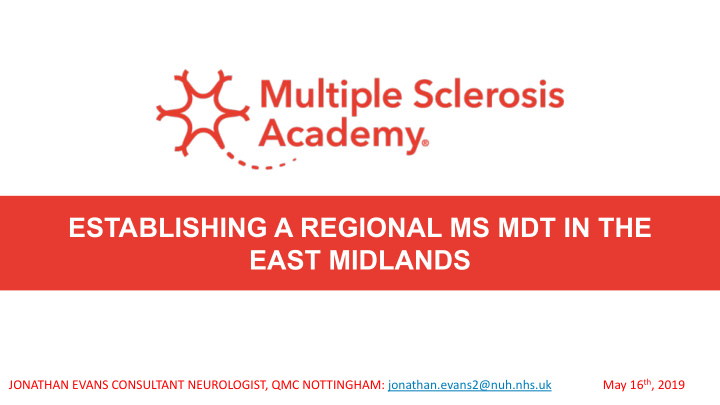



ESTABLISHING A REGIONAL MS MDT IN THE EAST MIDLANDS JONATHAN EVANS CONSULTANT NEUROLOGIST, QMC NOTTINGHAM: jonathan.evans2@nuh.nhs.uk May 16 th , 2019
NHS England Guidance 9/2018 (Updated 3/2019) • Provides a framework to decision-making on MS DMTs • Consistent, effective and safe prescribing • Takes account of regulatory and commissioning status, and NICE guidance (http://pathways.nice.org.uk/pathways/multiple-sclerosis)
Principles of Organisation of MS service for DMTS • Every region should make ALL LICENSED MS DRUGS available. MS PRESCRIBING SERVICE: ≥1 CONSULTANT NEUROLOGIST WORKING WITH ≥1 MS NURSE • All DMT prescribers must participate in regional networks with requirements for audit, QC and education: • DMT prescribing must be delivered by teams, and with higher-risk DMTs there is a requirement for discussion at an over-arching MDT meeting • Services should be designed to facilitate collection of mandatory data for audit and governance.
Stages in Development of MDT: 1.Evaluate Current Practice: Why? Common to Most Tertiary Centres, we are already running a weekly MS MDT at QMC. However, current arrangements ad hoc: • No single pathway for referral • Consultants bring their own cases and record discussions individually • A centralised record of outcomes is kept, but it is not searchable (rolling, tabulated document in MS Word) • Regional Centres do participate, but no established line for referral: Individual requests to MS Consultants and MS Coordinator, “Drop-in” discussions etc. As Venue and Time already arranged and agreed, existing structure can be used both as a framework for a new regional MDT, and a forum for discussion of the form this MDT should take Develop a working group for MDT development with a designated lead and work to a Timeline
Stages in Development of MDT: 2. Determine scope and Identify ‘stakeholders’: Who? Regional hospitals without MS Prescribing Service MS prescribing service Derby Loughborough • • Leicester Glenfield • • Boston • Lincoln • Northampton Grantham • • Kettering Newark • • Chesterfield Mansfield • • Sheffield Regional Neuroscience (historical links) Centre Nottingham QMC
Stages in Development of MDT: 3. Standard Operating Procedure: How? NHS England specifies minimum requirements for MDT: ≥2 MS Specialist Neurologists ≥1MS Nurse Specialist PLUS Neuroradiology and Pharmacy Expertise NUH Set-Up: ≥3/8 MS CONSULTANTS (+Chair) NEURO-RADIOLOGY LINK CONSULTANTS • • “CORE” MDT AND PATHWAY ≥1/3 MS NURSE SPECIALISTS + “NON-CORE” • NAMED NEURO-PHARMACIST • • MS CLINIC CO-ORDINATOR Formalise process: Job planning, Clearly defined roles, Standard Operating Procedure , Attendance Register, Timeline for Audit (Time, Venue already in place) Single Point of Access • Standard Method of Recording Streamline referral process and ensure good governance: • Single Output • As a non-MS Specialist, aim to come up with a system that minimised administrative burden on MS Co-ordinator Develop a proforma for exclusively electronic referrals, and make this “linkable” through Trust intranet in hubs
UNIVERSAL MS MDT REFERRAL PROFORMA (1)
UNIVERSAL MS MDT REFERRAL MDT outcome recorded in “real-time” by Chair PROFORMA (2) Protocol for referring patients for neuroradiology opinion – dovetailing with current NUH system Completed form is then: 1. Saved in shared access drive as a single permanent record of outcome 2. (Securely) E-mailed back to the source referrer
Implementation and Feedback Progress reports delivered at MDT, feedback reviewed and passed to “hubs” for comment Iterative and transparent process MS-MDT “Go-live” date for 5 th June 2019 Audit lead to review process at 6 months: • Number and distribution of referrals • Attendance register/compliance • Number of neuroradiology requests Business case for dedicated Neuro- radiologist? • % missing data in referrals
Summary and Conclusions Described the stages in developing a fit-for-purpose regional MS MDT Illustrates the importance of a team-working, problem-solving approach in achieving this. Strengths of this approach: ü Utilises existing systems/structures: Achievable ü Single point of access and simplified channels of communication: Good Clinical Governance ü Standardised recording of outcomes: Facilitate clinical audit ü Addresses particular local challenges: Realistic and sustainable Personal Perspective: What is my experience of managing a cohort of MSologists?
What is my experience of managing a cohort of MSologists?
Summary and Conclusions Described the stages in developing a fit-for-purpose regional MS MDT Illustrates the importance of a team-working, problem-solving approach in achieving this. Strengths of this approach: ü Utilises existing systems/structures: Achievable ü Single point of access and simplified channels of communication: Good Clinical Governance ü Standardised recording of outcomes: Facilitate clinical audit ü Addresses particular local challenges: Realistic and sustainable THANKYOU… …AND QUESTIONS? jonathan.evans2@nuh.nhs.uk
Recommend
More recommend